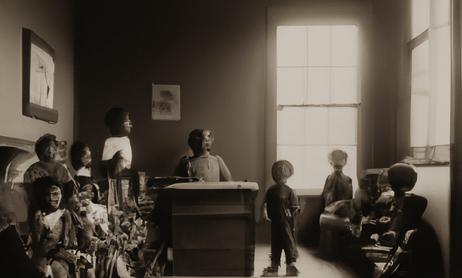Segregation in K-12 Education: The Jim Crow Era
This second in my series of articles about K-12 segregation covers The Jim Crow Era from 1877 to 1954, a dark time in American history characterized by widespread racial segregation and discrimination. This essay explores the historical context of the Jim Crow Era and its impact on K-12 education. By analyzing the policies, legal decisions, and struggles faced during this era, we can gain insights into the challenges and resilience of individuals and communities in the fight for educational equality.
Step back in time and delve into the dark period of American history known as the Jim Crow era, where racial segregation pervaded all aspects of society, including education. We'll look into the segregated schooling system that existed during this time, examining the disparities faced by African-American students. Explore the historical context, discriminatory policies, and the impact on educational opportunities for marginalized communities. Uncover the struggles, resilience, and pivotal legal battles that ultimately paved the way for progress in dismantling segregation. Gain insights into the enduring legacy of this era and its implications for the fight for educational equality in the present day.
......................................................................................................................................................................................................................................
Legalization of Racial Segregation
Plessy v. Ferguson and "Separate but Equal"
The Supreme Court's 1896 decision in Plessy v. Ferguson established the "separate but equal" doctrine, endorsing racial segregation in public facilities, including schools. This ruling legitimized the practice of segregated education.
Plessy v. Ferguson was a landmark Supreme Court case decided in 1896 that solidified the "separate but equal" doctrine, which allowed for racial segregation in public facilities, including schools. In this case, an African American, Homer Plessy, challenged a Louisiana law that required racial segregation on trains. The Court's ruling upheld the constitutionality of such segregation, stating that as long as the separate facilities were equal in quality, they did not violate the Fourteenth Amendment's equal protection clause. However, the reality was that these segregated facilities were far from equal, as they were often vastly inferior in resources, funding, and opportunities for marginalized communities. The "separate but equal" doctrine became a legal justification for racial segregation and entrenched systemic discrimination, perpetuating educational and societal disparities. Plessy v. Ferguson is a stark reminder of the struggles for equality and the importance of confronting and challenging discriminatory practices in our society.
State-Level Segregation Laws
Many states enacted laws that mandated segregated education. These laws perpetuated the segregation of African American and white students, reinforcing educational disparities.
For example, in 1896, Louisiana passed the Separate Car Act, which required separate railway accommodations for African American and white passengers, including separate seating in train cars. In 1901, Mississippi enacted the Separate Car Act, known as the "Jim Crow Car Law," which also mandated racial segregation on trains. In 1905, South Carolina passed the Separate Coach Act, enforcing racial segregation in public transportation. In 1908, Georgia passed the Georgia Equalization Act, which allocated separate educational funding for white and African-American schools. Other states, such as Alabama, Florida, North Carolina, and Texas, also implemented similar laws that enforced segregation in public life, including education, transportation, and public facilities. These laws entrenched segregation and perpetuated systemic racial inequality throughout the Jim Crow era.
This video chronicles the Jim Crow Laws and racial Segregation.
Educational Inequalities and Challenges
Underfunding of African-American Schools
African-American schools received significantly less funding than white schools. This underfunding resulted in overcrowded classrooms, outdated textbooks, and inadequate resources, creating a stark disparity in educational quality. One example of a state that underfunded African-American schools during the Jim Crow era is South Carolina. In 1895, the state passed an ordinance known as the South Carolina Dispensary Act, which significantly impacted the funding for African-American schools. This law established a state-controlled monopoly on the sale of alcohol and directed a portion of the revenue generated from alcohol sales to fund public education. However, the funding allocated to African-American schools was disproportionately low compared to that of white schools. The discriminatory distribution of funds perpetuated educational inequalities by providing inadequate resources and limiting educational opportunities for African-American students in South Carolina during the Jim Crow era.
Limited Curriculum and Educational Opportunities
African-American students were often denied access to comprehensive curricula and extracurricular activities. They were limited to vocational or agricultural training, denying them the same educational opportunities as their white counterparts.
......................................................................................................................................................................................................................................
African American Resistance and the Pursuit of Education
Formation of African American Teachers' Associations
African-American educators played a significant role in advocating for equal education. They formed associations such as the National Association of Teachers in Colored Schools, fighting for improved educational opportunities and resources.
Community-Led Efforts for Quality Education
African-American communities established their schools and institutions to provide quality education in the face of segregated systems. Historically Black Colleges and Universities (HBCUs) and Rosenwald Schools nurtured educational advancement within African-American communities.
......................................................................................................................................................................................................................................
The Road to Brown v. Board of Education
Legal Challenges to Segregated Education
African-American parents, activists, and organizations pursued legal challenges against segregated education. Landmark cases, such as Briggs v. Elliott and Sweatt v. Painter, set the stage for the eventual overturning of "separate but equal" in Brown v. Board of Education.
Landmark cases such as Briggs v. Elliott and Sweatt v. Painter played significant roles in paving the way for the groundbreaking Brown v. Board of Education decision. In Briggs v. Elliott (1950), a group of African-American parents in Clarendon County, South Carolina, challenged the constitutionality of segregated public schools, arguing that separate facilities were inherently unequal. The case ultimately reached the U.S. Supreme Court as part of the consolidated Brown case. Sweatt v. Painter (1950) involved Heman Sweatt, an African-American man who was denied admission to the University of Texas Law School solely due to his race. The Supreme Court held that the separate law school designated for African Americans was unequal to the education provided at the University of Texas Law School. These cases demonstrated the inadequacy of "separate but equal" in education and set crucial precedents that influenced the Supreme Court's ruling in Brown v. Board of Education (1954). The landmark decision in Brown overturned the doctrine of segregation, declaring that separate educational facilities were inherently unequal and violated the Fourteenth Amendment's Equal Protection Clause. The collective impact of these cases paved the way for desegregation efforts and marked a significant turning point in the fight against racial segregation in American education.
Brown v. Board of Education and Its Impact
The Supreme Court's 1954 ruling in Brown v. Board of Education declared segregation in public schools unconstitutional. This landmark decision marked a significant turning point in the fight against segregation and paved the way for desegregation efforts.
This video explains the case law inherent in Brown vs. Board of Education.
Conclusion
The Jim Crow Era entrenched racial segregation and perpetuated educational inequalities in K-12 education. Legal decisions and state-sanctioned segregation denied African-American students equal educational opportunities. However, the era also witnessed resistance and resilience as African-American communities fought for quality education. The path to Brown v. Board of Education was paved by the collective efforts of activists, educators, and community members who sought to dismantle the barriers to educational equality. Understanding the struggles and triumphs of this era informs our ongoing commitment to creating a more equitable and inclusive educational system.
Note
The sources used in this essay include "Simple Justice: The History of Brown v. Board of Education and Black America's Struggle for Equality" by Richard Kluger, "To Stand and Fight: The Struggle for Civil Rights in Postwar New York City" by Martha Biondi, "Southern Education and Missouri's Black Schools, 1865-1954" by Richard Allen Brown, "The Disappearing Mule: African American Education in the Jim Crow South, 1910-1940" by Katherine Capshaw Tate, and "The Education of Blacks in the South, 1860-1935" by James D. Anderson.
More resources
The National Museum of African American History and Culture's website features a section dedicated to the landmark Supreme Court case Brown v. Board of Education. It explores the history of segregated education during the Jim Crow era and the legal battle for equal educational opportunities. The site includes historical context, photographs, oral histories, and educational resources.
The Digital Public Library of America hosts an online exhibition titled "The Color Line: Segregation in America," which includes a section specifically on segregation in education. It delves into the experiences of African American students during the Jim Crow era, the impact of segregated schooling, and the efforts to resist and challenge segregation. The site offers photographs, primary source documents, and further reading suggestions.
Questions? Contact us on Facebook or Instagram. @publicschoolreview
#publicschools #segregation #jimcrowsegregation












